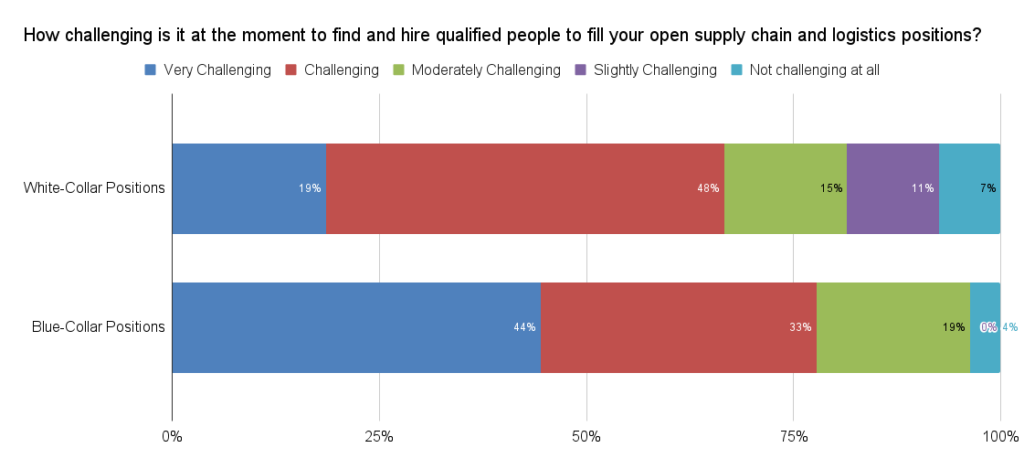As I highlighted last February in “The Labor Shortage Problem: Why It’s Bigger Than You Think And How To Address It,” which included insights from a presentation by labor economist Ron Hetrick titled “The Demographic Drought,” there are various factors leading to decreased labor availability around the world. Unfortunately, this problem is projected to get worse in the years ahead.
How challenging is it at the moment to find and hire qualified people to fill your open supply chain and logistics positions?
We asked members of our Indago supply chain research community (who are all supply chain and logistics executives from manufacturing, retail, and distribution companies) that question in February 2022.
19% of our member respondents said that finding and hiring qualified people to fill white-collar positions is currently “Very Challenging.” The problem is even more challenging, however, for filling blue-collar positions, with 44% of the respondents saying it is “Very Challenging.”

“It has become extremely difficult, if not impossible, to retain knowledgeable and experienced supply chain talent,” said one Indago supply chain executive. “When we lose them, we get very few responses to our postings, so it is taking a minimum of 3 months to hire someone and then another 3-6 months to bring them up to speed. This puts pressure on the rest of the organization — frustrating them and pushing them to leave — starting the cycle all over again.”
Another executive added, “Our company hasn’t rethought its hire-to-retire process, but we’re trying different incentive programs for referring people [to fill] job vacancies. It turns out that no company is immune from the great resignation despite how much they take care of their employees or how prestigious their company brand is.”
We also asked our Indago members if they believe talent management will become a competitive differentiator moving forward, and how they would rate their company’s overall performance in finding, hiring, training, and retaining supply chain and logistics employees. Indago members can download the report for all the results.
Are you transforming or innovating your approach to talent management in response to changes in the labor market? If so, in what ways? Is retaining employees a bigger challenge than finding and hiring them?
Post a comment and share your perspective!
Why Join Indago?
There are many reasons to join Indago, but here is the biggest one that differentiates us from other research organizations: your participation helps to make a difference in people’s lives.
To date, we have donated over $16,000 to various charities, including JDRF, American Logistics Aid Network, American Cancer Society, Feeding America, and Make-A-Wish.
That is the meaning behind our tagline: “Be Uncommon. Research with Purpose.”
If you’re a supply chain or logistics practitioner from a manufacturing, retail, or distribution company — and you’re interested in learning from your peers — I encourage you to learn more about Indago and join our research community. It is confidential, there is no cost to join and the time commitment is minimal (2-4 minutes per week) — plus your participation will help support charitable causes that make a difference in people’s lives.










